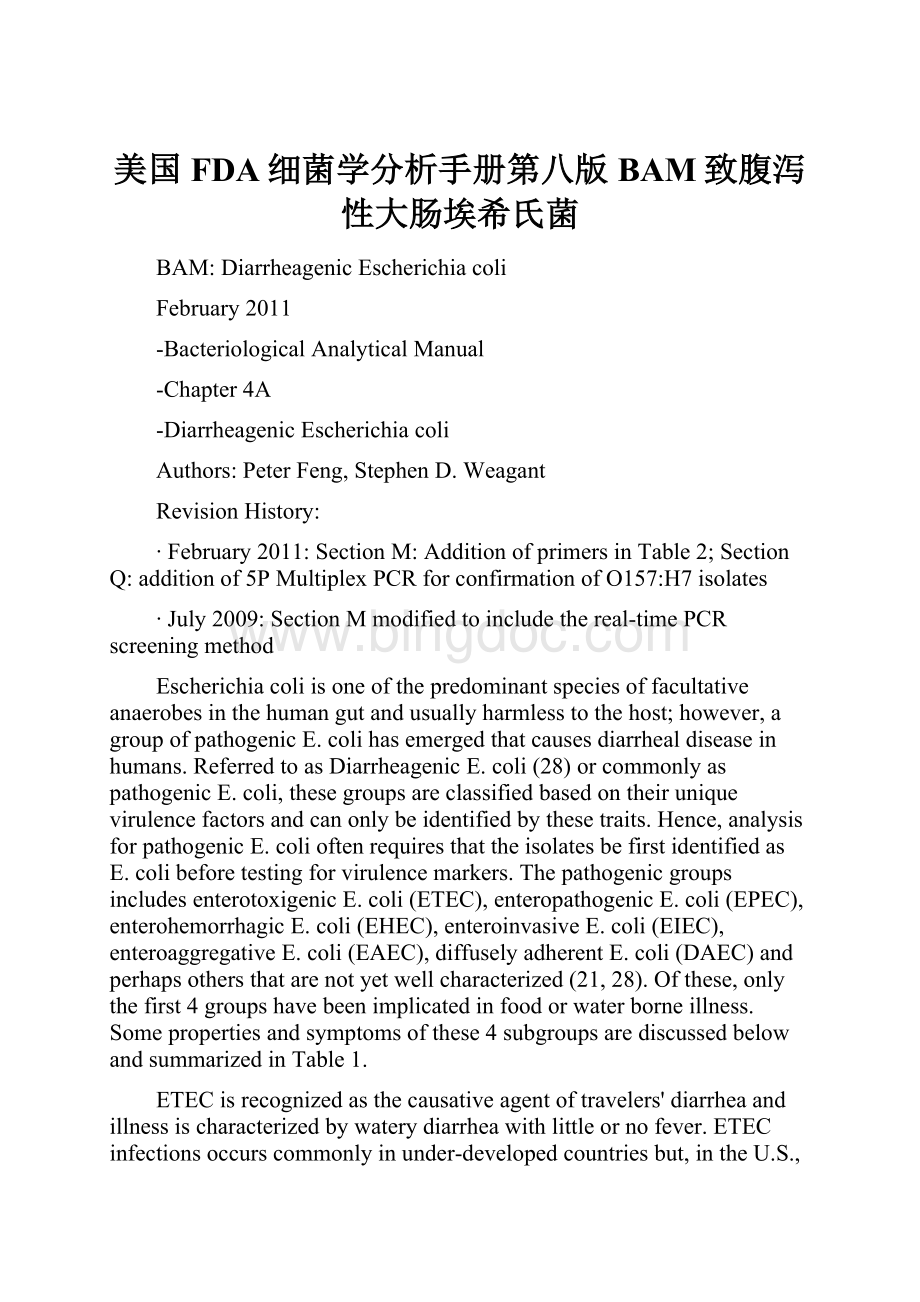美国FDA细菌学分析手册第八版BAM致腹泻性大肠埃希氏菌.docx
《美国FDA细菌学分析手册第八版BAM致腹泻性大肠埃希氏菌.docx》由会员分享,可在线阅读,更多相关《美国FDA细菌学分析手册第八版BAM致腹泻性大肠埃希氏菌.docx(42页珍藏版)》请在冰点文库上搜索。

美国FDA细菌学分析手册第八版BAM致腹泻性大肠埃希氏菌
BAM:
DiarrheagenicEscherichiacoli
February2011
-BacteriologicalAnalyticalManual
-Chapter4A
-DiarrheagenicEscherichiacoli
Authors:
PeterFeng,StephenD.Weagant
RevisionHistory:
∙February2011:
SectionM:
AdditionofprimersinTable2;SectionQ:
additionof5PMultiplexPCRforconfirmationofO157:
H7isolates
∙July2009:
SectionMmodifiedtoincludethereal-timePCRscreeningmethod
Escherichiacoliisoneofthepredominantspeciesoffacultativeanaerobesinthehumangutandusuallyharmlesstothehost;however,agroupofpathogenicE.colihasemergedthatcausesdiarrhealdiseaseinhumans.ReferredtoasDiarrheagenicE.coli(28)orcommonlyaspathogenicE.coli,thesegroupsareclassifiedbasedontheiruniquevirulencefactorsandcanonlybeidentifiedbythesetraits.Hence,analysisforpathogenicE.colioftenrequiresthattheisolatesbefirstidentifiedasE.colibeforetestingforvirulencemarkers.ThepathogenicgroupsincludesenterotoxigenicE.coli(ETEC),enteropathogenicE.coli(EPEC),enterohemorrhagicE.coli(EHEC),enteroinvasiveE.coli(EIEC),enteroaggregativeE.coli(EAEC),diffuselyadherentE.coli(DAEC)andperhapsothersthatarenotyetwellcharacterized(21,28).Ofthese,onlythefirst4groupshavebeenimplicatedinfoodorwaterborneillness.Somepropertiesandsymptomsofthese4subgroupsarediscussedbelowandsummarizedinTable1.
ETECisrecognizedasthecausativeagentoftravelers'diarrheaandillnessischaracterizedbywaterydiarrheawithlittleornofever.ETECinfectionsoccurscommonlyinunder-developedcountriesbut,intheU.S.,ithasbeenimplicatedinsporadicwaterborneoutbreaksaswellasduetotheconsumptionofsoftcheeses,Mexican-stylefoodsandrawvegetables.PathogenesisofETECisduetotheproductionofanyofseveralenterotoxins.ETECmayproduceaheat-labileenterotoxin(LT)thatisverysimilarinsize(86kDa),sequence,antigenicity,andfunctiontothecholeratoxin(CT).ETECmayalsoproduceaheatstabletoxin(ST)thatisoflowmolecularsize(4kDa)andresistanttoboilingfor30min.ThereareseveralvariantsofST,ofwhichST1aorSTpisfoundinE.coliisolatedfrombothhumansandanimals,whileST1borSThispredominantinhumanisolatesonly.TheinfectivedoseofETECforadultshasbeenestimatedtobeatleast108cells;buttheyoung,theelderlyandtheinfirmmaybesusceptibletolowerlevels.Becauseofitshighinfectiousdose,analysisforETECisusuallynotperformedunlesshighlevelsofE.colihavebeenfoundinafood.Also,ifETECisdetected,levelsshouldalsobeenumeratedtoassessthepotentialhazardofthecontaminatedfood.ProductionofLTcanbedetectedbyY-1adrenalcellassays(28)orserologicallybycommercialreversepassivelatexagglutinationassayandELISA(seeAppendix1).TheproductionofSTcanalsobedetectedbyELISAorbyinfantmouseassay(35).BothLTandSTgeneshavealsobeensequencedandPCR(37,41)andgeneprobeassays(seechapter24)areavailable.Analysisofcoloniesonplatingmediausinggeneprobe/colonyhybridizationalsoallowsenumerationofETECinfoods.
EIECcloselyresembleShigellaandcausesaninvasive,dysentericformofdiarrheainhumans(7).LikeShigella,therearenoknownanimalreservoirs;hencetheprimarysourceforEIECappearstobeinfectedhumans.AlthoughtheinfectivedoseofShigellaislowandintherangeof10tofewhundredcells,volunteerfeedingstudiesshowedthatatleast106EIECorganismsarerequiredtocauseillnessinhealthyadults.UnliketypicalE.coli,EIECarenon-motile,donotdecarboxylatelysineanddonotfermentlactose,sotheyareanaerogenic.PathogenicityofEIECisprimarilydueitsabilitytoinvadeanddestroycolonictissue.Theinvasionphenotype,encodedbyahighmolecularweightplasmid,canbedetectedbyinvasionassaysusingHeLaorHep-2tissueculturecells(7,25)orbyPCRandprobesspecificforinvasiongenes(seechapter24).
EPECcausesaprofusewaterydiarrhealdiseaseanditisaleadingcauseofinfantilediarrheaindevelopingcountries.EPECoutbreakshavebeenlinkedtotheconsumptionofcontaminateddrinkingwateraswellassomemeatproducts.ThroughvolunteerfeedingstudiestheinfectiousdoseofEPECinhealthyadultshasbeenestimatedtobe106organisms.PathogenesisofEPECinvolvesintiminprotein(encodedbyeaegene)thatcausesattachmentandeffacinglesions(14);butitalsoinvolvesaplasmid-encodedproteinreferredtoasEPECadherencefactor(EAF)thatenableslocalizedadherenceofbacteriatointestinalcells(36).ProductionofEAFcanbedemonstratedinHep-2cellsandthepresenceofeaegenecanbetestedbyPCRassays(28).
EHECarerecognizedastheprimarycauseofhemorrhagiccolitis(HC)orbloodydiarrhea,whichcanprogresstothepotentiallyfatalhemolyticuremicsyndrome(HUS).EHECaretypifiedbytheproductionofverotoxinorShigatoxins(Stx).AlthoughStx1andStx2aremostoftenimplicatedinhumanillness,severalvariantsofStx2exist.TherearemanyserotypesofStx-producingE.coli(STEC),butonlythosethathavebeenclinicallyassociatedwithHCaredesignatedasEHEC.Ofthese,O157:
H7istheprototypicEHECandmostoftenimplicatedinillnessworldwide(3,13,19,28).TheinfectiousdoseforO157:
H7isestimatedtobe10-100cells;butnoinformationisavailableforotherEHECserotypes.EHECinfectionsaremostlyfoodorwaterborneandhaveimplicatedundercookedgroundbeef(3,13),rawmilk(31),coldsandwiches(19),water(34),unpasteurizedapplejuice
(2)andsproutsandvegetables(4,17).EHECO157:
H7arephenotypicallydistinctfromE.coliinthattheyexhibitslowornofermentationofsorbitolanddonothaveglucuronidaseactivity(seechapter4.LST-MUGfordetails);hence,thesetraitsareoftenusedtoisolatethispathogenfromfoods.TheproductionofStx1andStx2canbetestedbycytotoxicityassaysonveroorHeLatissueculturecellsorbycommerciallyavailableELISAorRPLAkits(seeAppendix1).Geneprobes(seechapter24)andPCRassaysspecificforstx1andstx2andothertraitEHECmarkersarealsoavailable(12,15)(andseebelow).
Table1.SomepropertiesandsymptomsassociatedwithpathogenicE.colisubgroups.
Properties/Symptoms
ETEC
EPEC
EHEC
EIEC
Toxin
LT/STa
-
ShigaorVerotoxin
(StxorVT)
-
Invasive
-
-
-
+
Intimin
-
+
+
-
Enterohemolysin
-
-
+
-
Stool
Watery
Watery,Bloody
Watery,verybloody
Mucoid,bloody
Fever
Low
+
-
+
Fecalleukocytes
-
-
-
+
Intestineinvolved
Small
Small
Colon
Colon,lowersmall
Serology
Various
O26,O111&others
O157:
H7,O26,O111&others
Various
IDb
High
High
Low
High
aLT,labiletoxin;ST,stabletoxin.
bID,infectivedose.
IsolationandIdentificationofPathogenicEscherichiacoli
-ExceptEHECofserotypeO157:
H7
SincepathogenicE.coliareidentifiedbasedonitsuniquevirulenceproperties,theanalyticalprocedureforthesepathogensinfoodsgenerallyrequirestheisolationandidentificationoftheorganismsasE.colibeforetestingforthespecificvirulencetraits.FollowingisageneralprocedureforenrichmentandisolationofpathogenicE.colifromfood(25).
A.Equipmentandmaterials5
B.Media5
C.Reagents,inorganic,organic,andbiological5
D.Enumeration.6
E.EnrichmentforPathogenicE.coli6
F.Selection.6
G.ConventionalBiochemicalScreeningandidentification(8,30)7
H.TestsforEnterotoxigenicE.coli(ETEC)8
I.TestsforEnteroinvasiveE.coli(EIEC)8
J.TestsforEnteropathogenicE.coli(EPEC)8
K.ScreeningmethodforE.coliSerotypeO157:
H7fromFoods9
L.Equipmentandmaterials10
M.MediaandReagents11
N.SamplePreparationandEnrichmentProcedure14
O.Real-timePCRScreening15
P.CulturalIsolationandPresumptiveIsolateScreening.24
Q.IsolateConfirmationTests27
R.Screeningmethodfornon-O157STEC31
References33
A.Equipmentandmaterials
1.Balance,≥2kgwith0.1gsensitivity
2.Blender,Waringorequivalentmodelwithlowspeedoperationat8000rpm,with1literglassormetaljar
3.Incubators,35±0.5°Cand44±1°C
4.Petridishes20x150mm
5.Pipets,Pasteur
6.pHtestpaper,range6.0-8.0
B.Media
1.Tryptonephosphate(TP)broth(M1621)
2.Brainheartinfusion(BHI)broth(M242)
3.Levine'seosin-methyleneblue(L-EMB)agar(M803)
4.MacConkeyagar(M914)
5.Triplesugariron(TSI)agar(M1495)
6.Bloodagarbase(BAB)(M216)
7.Tryptone(tryptophane)broth(M1647)
8.Bromcresolpurplebroth(M268)supplementedindividuallywith0.5%(w/v)ofeach:
glucose,adonitol,cellobiose,sorbitol,arabinose,mannitol,andlactose
9.Ureabroth(M1719)
10.Lysinedecarboxylasebroth,Falkow(M8710).
11.Potassiumcyanide(KCN)broth(M12611)
12.MR-VPbroth(M10412)
13.Indolenitritemedium(trypticnitrate)(M6613)
14.Acetateagar(M314)
15.Mucatebroth(M10515)
16.Mucatecontrolbroth(M10616)
17.Malonatebroth(M9217)
18.Koser'scitratebroth(M7218)
C.Reagents,inorganic,organic,andbiological
1.Sodiumbicarbonatesolution,10%,aqueous(sterile)(R7019)
2.ONPG(o-nitrophenyl-β-D-galactopyranoside)disks(R5320)
3.Phosphatebufferedsalinesolution,(sterile)(PBS)(R6021),orButterfield'sPhosphate-buffereddilutionwater(BPBW)(R1122).
4.Kovac'sreagent(R3823)
5.VPreagents(R8924)
6.Oxidasetestreagent(R5425)
7.Nitritedetectionreagents(R4826)
8.Mineraloil,heavysterile(R4627)
9.Gramstainreagents(R3228)
D.Enumeration.
Refrigeratesamplespromptlyafterreceipt.Donotfreezeexcepttoholdfrozenproductsuntiljustpriortoanalysis.Analyzesamplesassoonaspossible.Ifenumerationisrequired,prepareahomogenateof25